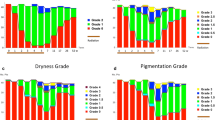Abstract
Purpose
The aim of this study was to assess radiation dermatitis, especially exploring the influence of neoadjuvant systemic therapy (NST).
Materials and methods
We examined maximum toxicity using the Common Toxicity Criteria version 3 score (CTC v3) following radiotherapy between 40 patients treated with NST and 59 patients without NST. In addition, objective skin color (L*, a*, b* values) and moisture analyses were applied in 13 NST and 25 control patients, and the ratio of the values for the irradiated side to the nonirradiated side was calculated.
Results
For the CTC v3 assessment, 27 grade 1 (68%) and 13 grade 2 (32%) reactions occurred in the NST group and 44 grade 1 (75%) and 15 grade 2 (25%) reactions in the control group. All ratios except the b* ratio showed significant alterations when radiotherapy was added. The ratio of the a* value peaked at the completion of radiotherapy, whereas the L* ratio bottomed out 1 month later. Furthermore, moisture change remained even 1 year after treatment. Boost irradiation doses caused enhanced alterations in the L* and a* ratios. Furthermore, the L* and a* ratios had good agreement with the CTC v3 assessment. NST did not enhance alterations.
Conclusion
Objective analysis is useful for detailed assessment of radiation dermatitis. NST did not worsen skin reactions.
Similar content being viewed by others
References
Fisher B, Bryant J, Wolmark N, Mamounas E, Brown A, Fisher ER, et al. Effect of preoperative chemotherapy on the outcome of women with operable breast cancer. J Clin Oncol 1998;16:2672–2685.
Fisher B, Brown A, Mamounas E, Wieand S, Robidoux A, Margolese RG, et al. Effect of preoperative chemotherapy on local-regional disease in women with operable breast cancer: findings from National Surgical Adjuvant Breast and Bowel Project B-18. J Clin Oncol 1997;15:2483–2493.
Van der Hage JA, van de Velde CJ, Julien JP, Tubiana-Hulin M, Vandervelden C, Duchateau L. Preoperative chemotherapy in primary operable breast cancer: results from the European Organization for Research and Treatment of Cancer trial 10902. J Clin Oncol 2001;19:4224–4237.
Kawashima M, Nozaki N, Furuta M, Nakamura M, Komazaki K, Izawa Y. Objective assessment of breast skin reactions after breast-conserving therapy. J Jpn Soc Ther Radiol Oncol 2007;19:273–276.
Momm F, Bartelt S, Haigis K, Grosse-Sender A, Witucki G. Spectrophotometric skin measurements correlate with EORTC/RTOG-common toxicity criteria. Strahlenther Onkol 2005;181:392–395.
Clarys P, Alewaeters K, Lambrecht R, Barel AO. Skin color measurements: comparison between three instruments: the Chromameter®, the DermaSpectrometer® and the Mexameter®. Skin Res Technol 2000;6:230–238.
Heinrich U, Koop U, Leneveu-Duchemin MC, Osterrieder K, Bielfeldt S, Chkarnat C, et al. Multicentre comparison of skin hydration in terms of physical-, physiological- and product-dependent parameters by the capacitive method (Corneometer CM 825). Int J Cosmet Sci 2003;25:45–53.
Sekine H, Sugenoya J, Fukuda I, Honda C, Kobayashi M, Aoki M, et al. Long-term, irradiation-induced effects on thermoregulation in the skin after thermal stimulation. Radiat Med 2004;22:413–421.
Inomata T, Ogawa Y, Nishioka A, Terashima M, Kariya S, Masaki K, et al. Changes in blood flow and skin reaction following radiation therapy. Nippon Acta Radiol 1995;55:58–64.
Arbogast JW, Fendler EJ, Hammond BS, Cartner TJ, Dolan MD, Ali Y, et al. Effectiveness of a hand care regimen with moisturizer in manufacturing facilities where workers are prone to occupational irritant dermatitis. Dermatitis 2004;15:10–17.
Frieben H. Demonstration eines Cancroid des rechten Handruckens, das sich nach langdauernder Einwirkung von Rontgenstrahlen entwickelt hatte. Fortschr Rontgenstr 1902;6:106–111.
Nyström J, Geladi P, Lindholm-Sethson B, Geladi P, Larson J, Franzén L. Objective measurements of radiotherapyinduced erythema. Skin Res Technol 2004;10:242–250.
CIE. CIE 1976 uniform color space. In: Colorimetry. Wien: CIE Publication; 1986. p. 29–32.
Hymes SR, Strom EA, Fife C, Radiation dermatitis: clinical presentation, pathophysiology, and treatment 2006. J Am Acad Dermatol 2006;54:28–46.
Kim SD, Kim SW, Huh CH, Suh DH, Eun HC. Changes of biophysical properties of the skin measured by non-invasive techniques after Q-switched Nd-YAG laser therapy in patients with nevus of Ota. Skin Res Technol 2001;7:262–271.
Wolmark N, Wang J, Mamounas E, Bryant J, Fisher B. Preoperative chemotherapy in patients with operable breast cancer: nine-year results from National Surgical Adjuvant Breast and Bowel Project B-18. J Natl Cancer Inst Monogr 2001;30:96–102.
Sautter-Bihl ML, Budach W, Dunst J, Feyer P, Haase W, Harms W, et al. DEGRO practical guidelines for radiotherapy of breast cancer. I. Breast-conserving therapy. Strahlenther Onkol 2007;183:661–666.
Author information
Authors and Affiliations
Corresponding author
About this article
Cite this article
Yamazaki, H., Yoshida, K., Kotsuma, T. et al. Longitudinal practical measurement of skin color and moisture during and after breast-conserving therapy: influence of neoadjuvant systemic therapy. Jpn J Radiol 27, 309–315 (2009). https://doi.org/10.1007/s11604-009-0345-0
Received:
Accepted:
Published:
Issue Date:
DOI: https://doi.org/10.1007/s11604-009-0345-0




